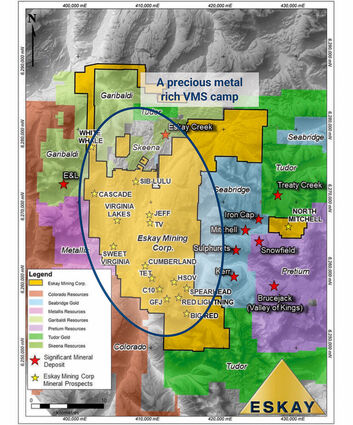Eskay Mining drills exciting VMS in BC
Explorer awaiting assays from 98 holes drilled west of KMS North of 60 Mining News – October 15, 2021
Last updated 10/14/2021 at 2:11pm
Eskay Mining Corp. Oct. 13 announced the conclusion of a roughly 23,500-meter drill program at its Consolidated Eskay precious metals project in British Columbia's Golden Triangle.
Eskay's aggressive 2021 drill program is primarily focused on following up on two gold- and silver-enriched VMS discoveries – TV and Jeff – made last year.
Out of 20 holes drilled at these targets last year, 18 cut impressive precious metal intercepts.
Highlights from the 2020 drilling at TV include:
• 10.1 meters averaging 4.17 grams per metric ton gold and 40.2 g/t silver in hole TV20-36.
• 17.5 meters averaging 2.58 g/t gold and 58.7 g/t silver in TV20-37.
• 29.9 meters averaging 3.18 g/t gold and 25.7 g/t silver in TV20-40.
Highlights from the 2020 drilling at Jeff includes:
• 24.6 meters averaging 1.54 g/t gold and 31.3 g/t silver in J20-31
• 35.5 meters averaging 9.5 g/t gold and 70 g/t silver in J20-33.
• 50.4 meters averaging 1.13 g/t gold and 43.5 g/t silver in J20-38.
Located about 2,000 meters apart, TV and Jeff were previously considered as separate systems, but geophysical data indicates that they may be geologically connected and part of a larger system.
Although the planned drill program designed to bridge the TV and Jeff deposits was cut short due to early-season snowstorms in mid-September, one of the last drill holes completed this season did cut an impressive 86 meters of replacement-style sulfide mineralization about 300 meters north of TV and 1,700 meters south of Jeff.
Eskay says this discovery of sulfide mineralization in hole TV21-81 corresponds closely to one of several discrete geophysical anomalies occurring between TV and Jeff, providing further evidence that these deposits may be part of a larger mineralized system.
Late season drilling also discovered exhalative massive sulfide mineralization at the top of what is now recognized as an extensive volcanogenic massive sulfide stockwork feeder system at TV.
Eskay says the discovery of such a horizon was one of the top goals of its exploration team, which postulated such a deposit should be present based upon observations of increasingly altered and silicified host rocks high in this system.
The company says several holes cut sulfide minerals such as pyrite and sphalerite in this horizon. Much like the hole between TV and Jeff, this newly discovered massive sulfide horizon corresponds closely to a discrete conductive electromagnetic geophysical anomaly. Below this newly discovered massive sulfide body, Eskay says multiple drill holes encountered long intercepts of intense stockwork feeder mineralization below this horizon.
This newly discovered massive sulfide and stockwork feeder system remain open along strike and down dip. A second, lower massive sulfide body found in 2020 was explored further in 2021 and is located at a distinct older seafloor position than the upper massive sulfide body. Eskay says these findings confirm that TV is a stacked VMS deposit similar to those in the Noranda Camp, Quebec.
"Discovery of massive sulfide mineralization atop the TV VMS system and sulfide mineralization in between TV and Jeff are a great way to end the drill season," said Quinton Hennigh, a director and technical advisor to Eskay Mining.
Late season drilling at C10, a target about eight kilometers (five miles) south of TV, encountered Upper Hazelton Group stratigraphy, including the Eskay Rhyolite with intervals of carbonaceous mudstone, the host rocks for the deposits on Skeena Resources Ltd.'s Eskay Creek gold-silver deposit about 20 kilometers (12.5 miles) to the north. Eskay says this is the first confirmation that these critical host rocks are present in this area at the south end of its 130,000-acre property.
Several drill holes cut broad sections of massive sulfide mineralization at the Vermillion VMS discovery east of C10. Significant sphalerite (zinc mineral), galena (lead mineral), and chalcopyrite (copper mineral) were encountered, indicating this system is notably enriched in base metals.
Eskay says these long sections of mineralization, coupled with extensive outcropping massive sulfide mineralization, confirm that Vermillion represents a major new VMS discovery.
In addition to the drilling, groundwork at Scarlet Ridge (previously known as New York, but the name was changed to avoid confusion with another prospect in the area) confirms that this area several kilometers northeast of Jeff hosts extensive rhyolite-hosted VMS mineralization over a strike length of at least 1,500 meters.
Despite snowstorms cutting the season short, the 23,500 meters of drilling in 98 holes represents 78% of the targeted 30,000 meters of drilling originally planned.
"Eskay's exploration team led by Dr. John DeDecker has accomplished a long list of goals this season," said Hennigh. "We are delighted with this season's accomplishments and look forward to seeing assays from drilling, rock chip sampling and soils programs."
Like all Alaska and northern Canada projects, the turnaround time for Eskay Mining drill results from assay labs is slow due to an extremely active exploration season; restrictions and protocols related to COVID; and a chronic shortage of labor, especially at sample preparation facilities.


















Reader Comments(0)